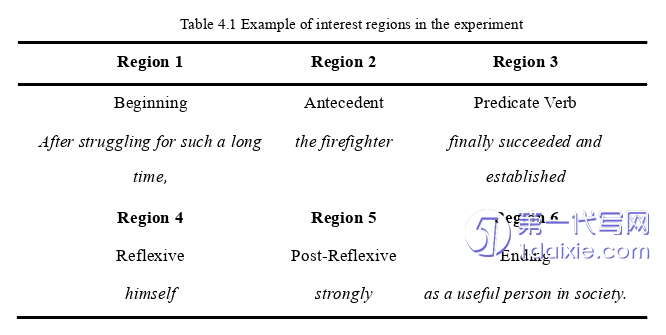本文是一篇英语毕业论文,本文结果表明,以汉语为母语的中国英语学习者未能即时发现典型性别角色名词与反身代词的性别冲突,但确实出现性别冲突的即时性倾向,男性和女性典型性别角色名词对反身代词加工影响稍有不同。该结果为浅层结构假说提供支持证据。
Chapter One Introduction
1.1 Background of the research
The premise of understanding a sentence or discourse require the establishment of more or less connections between various components, such as the close relationship between anaphora components such as reflexive pronouns (i.e. himself/herself) and antecedents. Online processing of L2 anaphoric components containing pronouns and reflexive pronouns, in which reflexive pronouns have grammatical features such as person, sex, or number, but lack referential ability, and they must be accompanied by noun phrase anaphora in sentences.
Resolution of reflexive pronouns in anaphora components is a process in which readers or listeners acquire meaning from antecedents or noun phrases in the context of the sentence after encountering reflexive pronouns during reading or listening. The process of reflexive anaphora resolution attracts researchers from different disciplines to conduct in-depth research on various factors affecting reflexive anaphora resolution from various perspectives (Wu et al., 2018). Most psycholinguistic studies have investigated the effect of gender typicality on anaphora resolution of English pronouns (e.g., the eye-tracking method, Ologisturt, 2003; Duffy and Keir, 2004; Kreiner et al., 2008; ERP method, Osterhout and Mobley, 1995; Osterhout et al., 1997). Referring to gender through the use of reflexive pronouns (himself/herself), they have found that there is a mismatch effect between the antecedent region and the pronoun region or the subsequent region. At present, the research on L2 anaphoric components begin to shift from offline disambiguation research to online processing research, that is, from offline data collection after the end of language activities to online data collection while the language activity is in progress, as a way to understand the mental processes of bilingual acquisition (Kim et al., 2015; Wu, 2016).

1.2 Objectives of the research
In natural gender language, typical gender role nouns have no morphological process, and most of them provide gender clues in the resolution of reflexive reference and role noun antecedents. Role nouns are a useful tool for studying gender typicality. The study intends to examine the online processing mechanism of reflexive anaphora resolution by Chinese EFL learners reading obscure typical gender role nouns through an eye-tracking approach to investigate the impact of typical gender role nouns on the process of text comprehension automation during reading, answering the question of whether Chinese EFL learners can immediately detect gender conflict between typical gender role nouns and reflexive pronouns in their online processing, and whether the different gender information of role nouns would affect the gender consistency or conflict of antecedents and reflexive pronouns.
The antecedents in this study include male typical gender role nouns with high prominence and female typical gender role nouns with high prominence. Typical gender role nouns are mainly derived from gender cognitive differences caused by stereotypes, such as firefighter, which is generally considered to be male typical role nouns and preschool teacher is generally classified as a female typical gender role nouns. A gender stereotype is a cognitive construct that encompasses the perceiver’s knowledge, beliefs, and desires about a particular group of people (Hamilton & Trolier, 1986, p. 133). The gender stereotype may stem from perceptions of the actual distribution of male and female in different occupational roles. For example, people tend to classify engineers as male rather than female, and car show models as female instead of male. This gender stereotype explains our realistic expectations and may produce relevant behavioral consequences. It is common-sense knowledge that the reader has acquired in life, which is not necessarily correct, and incorrect gender distribution may lead to eventual difficulties in comprehension, depending on other information such as the context of the sentence.
Chapter Two Literature Review
2.1 Definition of anaphora resolution
Reflexive pronouns are an important device of maintaining discourse coherence. Reflexive anaphora resolution is a process in which the reader or listener obtains meaning from the antecedents or noun phrases in the context of a sentence after encountering reflexive pronouns during reading or listening (Wu et al., 2018). Understanding a sentence needs to span multiple words or sentence elements to form a dependency relationship between sentence elements. A typical example is anaphora resolution. Anaphora resolution can quickly link pronouns or reflexive pronouns to their antecedents, which is of great help to the successful comprehension of a sentence or discourse. Therefore, anaphora resolution can help understand the memory system in language. The anaphora phenomenon formed in the process of language processing obviously implies the memory mechanism of language understanding. To explain anaphora, we need to extract antecedents from memory, such as Hu & Chen (2014) used ERP techniques to investigate the sensitivity of late Chinese-English bilinguals with high proficiency to the processing of English long-distance subject-predicate consistency structure. The results suggest that there is no front left hemisphere negative wave (LAN) reflecting automatic syntactic processing and no P600 effect was produced at the syntactic violation. The results show that it is difficult for late Chinese English bilinguals with high proficiency to process English subject-predicate consistency information in real-time and automatically under long-distance conditions. During anaphora resolution, antecedents can be retrieved from syntactic, semantic, and discourse-level factors. Clues such as gender consistency, syntactic constraints, and discourse prominence may affect the retrieval of antecedents, and this consistency may affect memory retrieval in the process of language comprehension (Nicol & Swinney, 2008).
2.2 Related studies of reflexive anaphora resolution
This paper elaborates on the relevant studies on reflexive pronoun anaphora resolution from the perspective of native speakers and L2 speakers, clarifies the research methods, research tools and research limitations of L1 and L2, and then studies the online processing mechanism of reflexive anaphora resolution on the basis of L1.
2.2.1 Native speakers’ reflexive anaphora resolution
Research on syntactic processing in native speakers has found that syntactic processing is highly automatic and that people can effectively integrate the semantic and syntactic information of sentences within a short time to understand the deeper representations of sentences (Jackson & Roberts, 2010; Kotz, Holcomb & Osterhout, 2008). Gender consistency is an important syntactic device for maintaining discourse coherence, and many studies have targeted pronoun processing to examine gender consistency. When reflexive pronouns encounter gender mismatched typical gender role nouns, readers slow down their reading, and this mismatch effect were assigned to a conflict between the gender of the reflexive pronoun and the gender information associated with the typical gender role noun. Native speakers are able to quickly and accurately associate the reflexive expression with the antecedent to understand the meaning of the sentence. For native speakers, gender inconsistency may trigger a mismatch effect and increase the reading time.
Chapter Three Methodology…………………………..29
3.1 Research questions and hypotheses……..……………….29
3.2 General design………………………….30
3.3 Research methods………………………………30
Chapter Four Results and Discussion…………………………39
4.1 Data analysis and results………………….……….39
4.1.1 The antecedent region…………………………40
4.1.2 The reflexive region ………………………44
Chapter Five Conclusion………………………60
5.1 Main findings of the research……………………………..60
5.2 Implications of the research……………………….61
Chapter Four Results and Discussion
4.1 Data analysis and results
The average comprehension accuracy of the current experiment was 84.4%, and the judgment accuracy of the participants was relatively high and correct. It shows that the participants read the sentences carefully with high reliability, and the data obtained are reliable. After the experiments were completed, the Data Viewer was used for data integration. Firstly, the obtained data were cleaned to remove data for fixation points less than 80ms or more than 1200ms, and to exclude the abnormal value that is more than 3 standard deviations of the average value of the participant, because fixation points with too long or too short eye movements do not reflect reading processing (Rayner, 1998). A total of 0.9% of the trials were excluded. Once the data were sorted out, a linear mixed-effects model was conducted using the lme4 package in R language software (version 4.0.2) (Baayen et al., 2008), with participants and items set as random factors. The data collection was based on sentences with fixation points, and high skimming rate may bring about a decrease in the reliability of the data collection, so to ensure the validity of the data, this study first divided the experimental sentences into six interest regions (See Table 4.1 for the specific division of interest regions).

Chapter Five Conclusion
5.1 Main findings of the research
This research found that native Chinese EFL learners were unable to immediately detect online processing of gender match between typical gender role nouns and reflexive in real time, and that information about the gender of the role noun did not affect online processing of the gender consistency in antecedents and reflexive pronouns. Chinese ELL learners were not sensitive to the gender factor with reflexive pronouns and did not differ significantly when dealing with gender inconsistencies with typical gender role nouns, the results may be due to the fact that Chinese ELL learners did not attempt to establish a dependency relationship between the reflexive pronoun and the antecedent, or there may be a dependency relationship but it is not showed in the eye-tracking measures of online processing, or it may be due to the influence of the native language, as the Chinese third-person singular, because although different in form, it has the same pronunciation. Therefore, the reflexive pronoun is indistinguishable, the possible factors of which need to be further verified.
The results of this study basically conform to the SSH that there are processing differences between the native and the L2 language. Unlike the native speakers, the second language processing of the bilingual can not reach the processing level of the native speakers, but there is a certain gender tendency. When the participants read female typical gender role nouns, the response time of gender conflict was longer than that of gender consistency. This study can not be used to explain to the Unified Competition Model that although second language learners may be affected by syntactic morphology, pronunciation as well as other native language systems, native language knowledge may migrate to second language learners as well. From the findings of the present research, it can be seen that this cross-language similarity does not affect the syntactic processing process of second language learners
reference(omitted)
